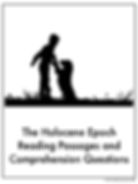
A Brief Overview of the Holocene Epoch for Middle School Science Classes
0
23
0
Earth history is a fascinating topic! It is also a massive topic! The reading passage below will teach you all about the Holocene epoch. If you want to learn more (and why wouldn't you?!), you can check out my Earth History page. I also have all of my passages available at Teachers Pay Teachers. They come with so many extras to get your students thinking about the content! I also recommend scrolling to the bottom of the page to check out my digital picture book on the Holocene epoch!

Whole New
The Holocene epoch is the most recent epoch in the Quaternary period. It is the epoch we are living in today. Holocene means “whole new” because all of the species living in the Holocene epoch are modern species.
Climate
The Holocene epoch began after the end of the last ice age. The climate of the Holocene epoch is much warmer than the climate of the Pleistocene epoch. Early in the epoch, many of the frozen tundras were replaced by the forests we see today.
Agriculture
The Holocene epoch is the epoch of humans. Even though early humans existed before the Holocene epoch, all of recorded history exists within the Holocene epoch. The first great human advancement of the Holocene epoch was the development of agriculture around ten thousand years ago.
The first farmers lived in the Fertile Crescent of the Middle East. They grew wheat, barley, peas, lentils, chickpeas, and flax. They also domesticated sheep, goats, and cattle. Farming soon spread throughout the world.
Carrying Capacity
With the invention of agriculture, humans became the first species to increase the carrying capacity of their environment. The carrying capacity is how many individuals an environment can support. Carrying capacity is limited by the availability of resources, predators, and space.
Humans have continued to increase the carrying capacity of the Earth throughout the Holocene epoch. In 100 CE, about 170 million people lived on Earth. By 1800, one billion people lived on Earth. Today, the Earth has a population of over 7.5 billion people.
Industrial Revolution
The Industrial Revolution of the nineteenth century was a major factor in increasing the population on Earth. Not only were goods produced cheaper and faster, but sanitation and medical care were also improved, so life expectancy increased.
Holocene Extinction
As the human population grows, it is having negative effects on the other species on Earth. Many scientists believe we are in the middle of a Holocene extinction event. They estimate that nearly 30 percent of the plant and animal species on Earth will be extinct in the next hundred years as a result of habitat destruction.
Humans are also changing the climate. Carbon dioxide released from burning fossil fuels is causing the Earth to get warmer. This warmer Earth is causing larger storms and droughts. Luckily, throughout history, humans have proved to be excellent problem solvers. There is hope that we will learn how to manage our environment and our climate to protect life on Earth.
Holocene Epoch Picture Book
Looking for another way to learn about the Holocene epoch? Check out this picture book version. The pages are a part of my Earth History bundle on Teachers Pay Teachers.






